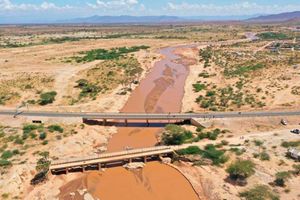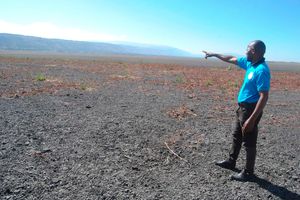Farmers' joy as dried-up rivers spring back to life

A resident washes utensils on the banks of River Kibwezi in Makueni County on May 16, 2023.
What you need to know:
- The rejuvenation of River Mang’elete coincided with that of River Kibwezi, which emerges from a spring at the heart of the township. It had also dried up completely for six years.
- Although the rejuvenated rivers are a pale shadow of their former selves, they have raised hope among local farming communities who depend on them for survival. At the height of the prolonged drought last year, the rivers defied negative speculation.
Until a year ago, Charles Mutua operated a boda boda at Mtito Andei in Makueni County. Today, the father of four dispatches at least 10 boda boda riders with sackloads of assorted vegetables daily to greengrocers after venturing into agribusiness. The change of fortunes is linked to the rejuvenation of River Mang’elete, which had dried up for years. The rejuvenation of this and other once-vibrant rivers in the semi-arid area has been as exciting to locals and conservationists as it is mysterious.
The long rains season had failed when a Healthy Nation team toured the Mang’elete region. However, many of the farmlands in the area were teeming with crops at various stages of maturity. Mr Mutua was picking capsicum in Mwaani Village.
“We are serving an order for 20 kilogrammes of capsicum which fetch Sh1,000 at the farm. We also grow okra, sukuma wiki and cow peas,” he said as he filled a sack of the popular vegetable. According to Mr Mutua, growing vegetables makes more business sense than operating a boda boda. His story is replicated across the region sandwiched by Chyulu Hills National Park and Tsavo West National Park. In Matangini Village, Lydia Mwaniki is in the race to reclaim her position as the biggest supplier of bananas, cassava, okra and sugarcane in the region. “Mang’elete is slowly regaining its lost glory as the hub of horticulture,” she said.

Charles Mutua harvests capsicum in Mwaani Village, Makueni County.
Thirteen years after River Mang’elete dried up, the sleepy neighbourhood is awash with stories of children who dropped out of school as their parents sank into depression as they stared at poverty. Its drying up preceded the drying up of orchards in the area. “We descended on the remaining fruit trees and cut them down to make charcoal,” said Esther Mumbua.
She is among peasants who embarked on intense prayers after their lifeline dried up. The ones who were financially well off sank wells. When it appeared that the interventions were futile, Mzee Ayub Mwalili relocated to Rombo area in the neighbouring Kajiado County, where he embarked on growing assorted vegetables on leased farmland. He returned home two years ago.
In its heyday, River Mang’elete supported hundreds of agribusiness ventures throughout the year. According to Mzee Leva Wambua,, the permanent river was so huge it was home to hippopotamuses. Its drying up in 2010 did not come as a surprise because it had gotten weaker and weaker over the years. In 2019, when the river started to slowly form after a wetland near Mang’elete Township had become swollen and soggy, many of the villagers didn’t expect much. There is no way the river could emerge since it was already dead, they thought.
“We assumed a wait-and-see attitude. The river defied the negative speculation. The following year, in 2021, the farming craze along the river started,” said Mr Wambua.
The rejuvenation of River Mang’elete coincided with that of River Kibwezi, which emerges from a spring at the heart of the township. It had also dried up completely for six years. Although the rejuvenated rivers are a pale shadow of their former selves, they have raised hope among local farming communities who depend on them for survival. At the height of the prolonged drought last year, the rivers defied negative speculation.
At the same time, the Water Resources Authority has reported an increase in the volumes of Kiboko, Kiu, Umani and Kambu springs in the last two years. Healthy Nation has established that Makindu, Kiunduani, Kibwezi, Kambu and Mtito Andei towns, which depend on water from the Kiu and Umani springs, have not experienced rationing in the last one year.
On the face of it, the rejuvenation of rivers Kibwezi and Mang’elete is seen as the outcome of concerted efforts to restore the Chyulu Water Towers, which had suffered decades of depletion. According to the Kenya Water Towers Agency, Chyulu is the largest water tower in Makueni County and its destruction would have far-reaching effects.
Some scientists such as David Kyule, a lecturer at the University of Nairobi, however, feel there is more than the recovery of the Chyullu ecosystem in the rejuvenation of the rivers.
The archaeologist, who has studied the region, links the rivers to Mt Kilimanjaro in Tanzania.
“The Chyulu ecosystem is too small to sustain Kiboko, Makindu, Umani, Kibwezi, Thange, Kambu, Mang’elete and Mzima Springs. They are recharged by Chyulu reservoir, a giant underground dam situated between Chyulu and Mount Kilimanjaro. It is the size of lakes Naivasha and Nakuru combined. The Chyulu reservoir is recharged by the melting of ice in Mt Kilimanjaro. Climate change explains the apparent changes,” Prof Kyule told Healthy Nation.
He noted that the increased pressure on the Chyulu reservoir explains the rejuvenation of the various springs along the Chyulu ranges.
“We call them breathers. They swell when the Chyulu reservoir is under intense pressure,” he said.
A Water Resources Authority official privy to the rejuvenation of the two rivers in Makueni has linked the development to “a swelling phenomenon similar to the one witnessed at lakes Naivasha and Nakuru. No one knows for sure why the water bodies are swelling”. The Kenya Water Towers Agency has not confirmed or denied the climate change theory. Instead, it has maintained that the rejuvenation of rivers Kibwezi and Mang’elete is a conservation upshot. “Vegetation cover enhances percolation of rain water into underground streams, which eventually emerge as springs,” said Winfred Musila, the director of research at Kenya Water Towers Agency.
When the Makueni County government held this year’s World Wetlands Day celebrations at the Kiu Springs, conservations were excited. They understood this as a gesture of the commitment of Governor Mutula Kilonzo Junior’s administration to protect the springs and the many others in the county. The governor then announced an ambitious programme to conserve springs in the area. Months later, however, work has not started.
pmaundu@ke.nationmedia.com


